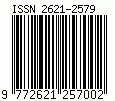The Americanized Journey of Chinese Immigrants: The Media Representation of Chinese Immigrants in Disney’s Elemental (2023)
DOI:
https://doi.org/10.12928/channel.v12i1.708Keywords:
Chinese immigrants, elemental, cultural integration, media representation, semiotic analysisAbstract
This paper explores the portrayal of Chinese immigrants in the animated film “Elemental,” using Roland Barthes’ semiotic framework to dissect the film’s narrative and thematic elements. “Elemental” serves as a modern allegory, reflecting the historical and ongoing struggles of Chinese immigrants in the United States, blending elements of cultural identity and adaptation within a fantastical setting. The film juxtaposes the fire element of immigrants with the traditional Chinese immigrant experience, examining themes of cultural integration, systemic discrimination, and the influence of media representation on public perceptions. Through denotative and connotative analyses, the research identifies how the film uses visual and verbal cues to construct a narrative that both challenges and perpetuates long-standing myths and stereotypes about Chinese immigrants. This study not only highlights the specific cinematic portrayal of Chinese immigrants but also discusses broader societal implications, including the impact of “Yellow Peril” propaganda and the role of media in shaping immigration policy discourse. The findings suggest that while “Elemental” contributes to a richer dialogue on cultural diversity, it also reveals the enduring complexities and challenges faced by Chinese immigrants in seeking acceptance and identity in a multicultural society.
References
Bernal, D. R., Misiasze, K. H., Ayala, J., & Kenley, N. (2022). Second-class citizens? Subjective social status, acculturative stress, and immigrant well-being. SN Social Sciences, 2(96). https://doi.org/10.1007/s43545-022-00371-2
Berger, A. A. (2018). Media analysis techniques. (6th ed.). SAGE Publications, Inc. ISBN: 9781506366203
Bertin, É. (2023). The Post-visual Moment: Towards a New Semiotic Economy of Visibility. ESSACHESS – Journal for Communication Studies 16(32): 127-147. https://doi.org/10.21409/0JWP-ZQ12
Chua, A. (2011). Battle Hymn of the Tiger Mother. New York: Penguin Books. ISBN 9780143120582
Chun, C. W. (2020). The return of the ‘Yellow Peril.’ Language, Culture and Society, 2(2), 252–259. https://doi.org/10.1075/lcs.00029.chu
Davenport, L. D. (2020). The fluidity of racial classifications. Annual Review of Political Science, 23(1), 221–240. https://doi.org/10.1146/annurev-polisci-060418-042801
Dooley, M. W. (2018). Fresh Off the Boat: Dispeller of Chinese American Stereotypes?. 應用英語期刊, (13), 29-68. https://www.airitilibrary.com/Article/Detail?DocID=P20110704003-201812-201903190016-201903190016-29-68
Elemental (2023) IMDb. https://www.imdb.com/title/tt15789038/
Fish, E. (2017, January 10). How Mixed Chinese-Western Couples Were Treated A Century Ago. Retrieved from Asia Society: https://asiasociety.org/blog/asia/how-mixed-chinese-western-couples-were-treated-century-ago
Foner, N. (2009). Across Generations: Immigrant Families in America. New York: New York University. ISBN-10 0814727719
Hardeman, R. R., Murphy, K. A., Karbeah, J., & Kozhimannil, K. B. (2018). Naming Institutionalized Racism in the Public Health Literature: A Systematic Literature Review. Public health reports (Washington, D.C. : 1974), 133(3), 240–249. https://doi.org/10.1177/0033354918760574
Kim, J. Y., & Kesari, A. (2021). Misinformation and hate speech: the case of Anti-Asian hate speech during the COVID-19 pandemic. Journal of Online Trust & Safety, 1(1). https://doi.org/10.54501/jots.v1i1.13
Knoll, T. (1982). Becoming Americans. OR: Coast to Coast Books. ISBN-10 0960266445
Kraut, R., & Skultety, S. (2005). Aristotle’s Politics: Critical Essays. Oxford: Rowman & Littlefield Publisher, Inc. ISBN 9780742534230
Kumaradjaja, L., & Kumaradjaja, C. (2024). Marion Evelyn Hong before and after the Curse of the Quon Gwon (1916). Journal of Chinese Cinemas. 1-19 https://doi.org/10.1080/17508061.2023.2292462
Lee, J. (2022). Return of the Yellow Peril? Racism, Xenophobia, and Bigotry Against Asian Americans. Bridgewater Review, 40(2), 7-10. Available at: https://vc.bridgew.edu/br_rev/vol40/iss2/5
Lyman, S. M. (2000). The “Yellow Peril” Mystique: Origins and Vicissitudes of a Racist Discourse. International Journal of Politics, Culture, and Society, 13(4), 683–747. http://www.jstor.org/stable/20020056
Nadeau, B. L., Liakos, C., Colliva , C., & Braithwa, S. (2023, September 15). 7,000 people arrive on Italian island of 6,000 as migrant crisis overwhelms Lampedusa. Retrieved from CNN: https://edition.cnn.com/2023/09/15/europe/italy-lampedusa-migrant-crisis-intl/index.html
Paché, G. (2022). Woke Culture Syndrome: Is research in management under threat? Journal of Management Research, 14(1), 1. https://doi.org/10.5296/jmr.v14i1.19323
PBS. (2008). History Detectives: Extended Interview - Chinese Immigration [Video]. PBS. https://www.pbs.org/video/history-detectives-extended-interview-chinese-immigration/
Pilkington, H. (2016). 6 ‘Second-class citizens’: Reordering privilege and prejudice. In Loud and proud: Passion and politics in the English Defence League (pp. 154-176). Manchester: Manchester University Press. https://doi.org/10.7765/9781526114013.00015
Putra, F. D., Cangara, H., & Ullah, H. (2022). Memes as a symbol of political communication. CHANNEL: Jurnal Komunikasi, 10(1). https://doi.org/10.12928/channel.v10i1.22326
Salim, M., Wibowo, A. A., & Hariyanti, N. (2023). Kajian Kebijakan Komunikasi Kesehatan Global Terkait Vaksinasi COVID-19. In Komunikasi dan Isu Global Kontemporer (pp. 83-98). Penerbit Samudra Biru. ISBN: 978-623-261-557-1
Simbolon, M., Ummanah, U., & Iswadi, I. (2023). Harmonious Coexistence: Intercultural Communication Dynamics Between Legal Immigrants and Residents in Gading Serpong. CHANNEL: Jurnal Komunikasi, 11(2), 172–177. https://doi.org/10.12928/channel.v11i2.455
Sobur, A. (2017). Semiotika Komunikasi. Bandung: PT. Remaja Rosdakarya. ISBN: 979692238X
Thompson, D. (2023, September 22). Disney Issues Statement on Elemental Streaming Viewership Following 'Flop' Reports. Retrieved from The Direct: https://thedirect.com/article/elemental-disney-flop-streaming
Wang, H. (2012). Portrayals of Chinese women's images in Hollywood mainstream film: An analysis of four representative films of different periods. Intercultural Communication Studies, 21(3), 82-91.
Wang, S. (2013). The “Tiger Mom”: Stereotypes of Chinese Parenting in the United States. Applied Psychology OPUS. Retrieved from https://wp.nyu.edu/steinhardt-appsych_opus/the-tiger-mom-stereotypes-of-chinese-parenting-in-the-united-states/
Weik, T. (2020, June 10). The history behind 'Yellow Peril Supports Black Power' and why some find it problematic . Retrieved from NBC News: https://www.nbcnews.com/news/asian-america/history-behind-yellow-peril-supports-black-power-why-some-find-n1228776
White, C. (2023, July 6). 10 years later, Pope Francis' Lampedusa 'cry' offers renewed call to welcome migrants. Retrieved from NCR Online: https://www.ncronline.org/vatican/vatican-news/10-years-later-pope-francis-lampedusa-cry-offers-renewed-call-welcome-migrants
Wong, M. G. (1989). A look at intermarriage among the Chinese in United States in 1980. Sociological Perspective, 32(1), 87-107. DOI: 10.2307/1389009
Wu, L., & Nguyen, N. (2022). From Yellow Peril to Model Minority and Back to Yellow Peril. AERA Open, 8. https://doi.org/10.1177/23328584211067796
Yeh, K.-H., & Bedford, O. (2004). Filial belief and parent-child conflict. International Journal of Psychology, 39(2), 132–144. https://doi.org/10.1080/00207590344000312
Zhou, M. (2009). Conflict, Coping, and Reconciliation: Intergenerational Relations in Chinese Immigrant Families. In N. Foner, Across Generations: Immigrant Families in America (pp. 21-46). New York and London: New York University. ISBN-10: 0814727719
Downloads
Published
How to Cite
Issue
Section
License
Copyright (c) 2024 Patrisia Amanda Pascarina, Louisa Christine Hartanto, Jennifer Esther

This work is licensed under a Creative Commons Attribution-ShareAlike 4.0 International License.






